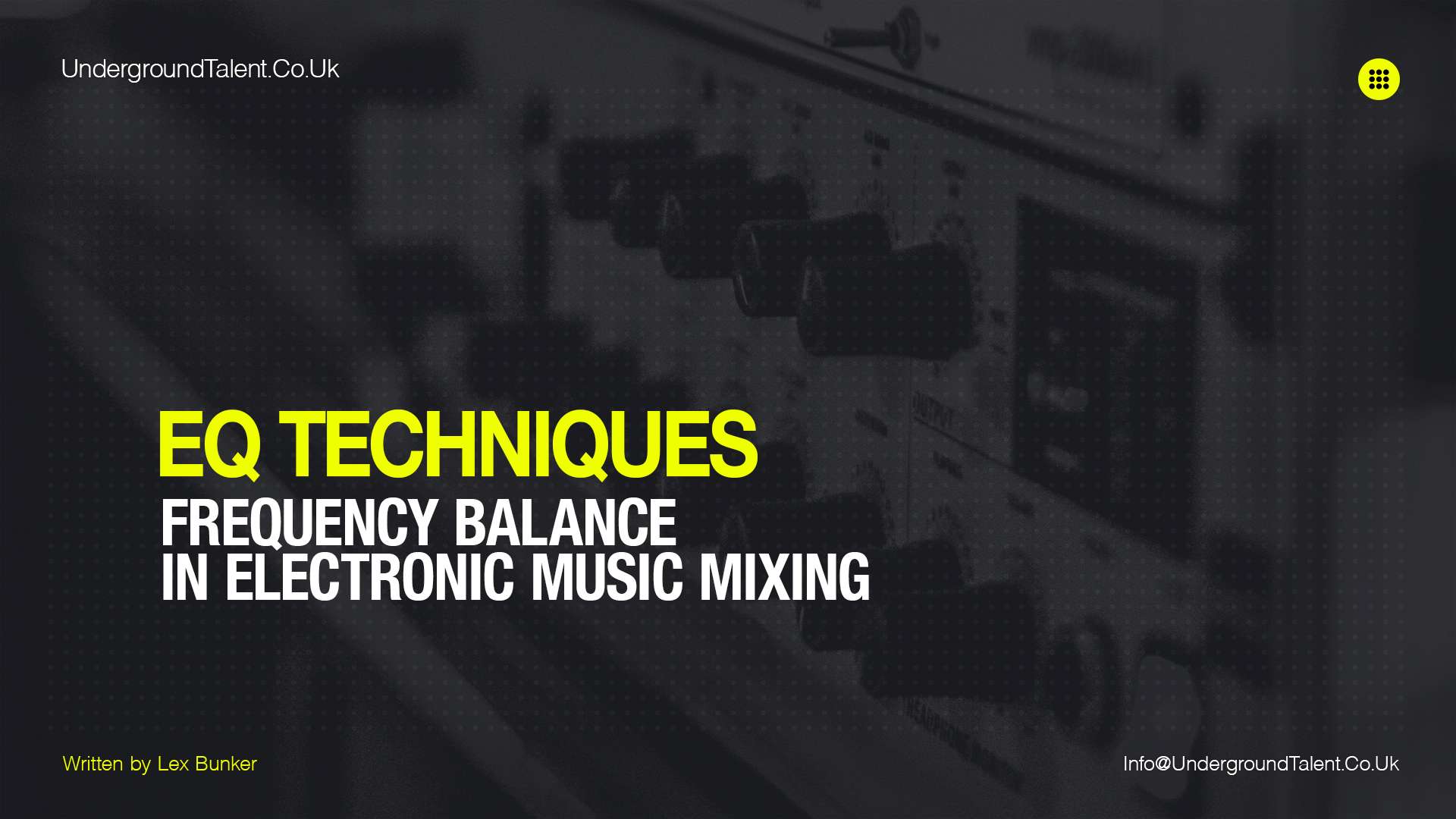EQ Techniques: Shaping the Frequency Balance in Electronic Music Mixing | Introduction
EQ techniques play a vital role in the world of electronic music mixing, allowing producers and engineers to shape the frequency balance and achieve sonic clarity. Understanding the importance of EQ in this process is key to crafting professional and impactful mixes.
By manipulating the frequency spectrum, EQ empowers music creators to enhance individual elements, create balance, and make the track come alive. In this article, we will delve into the significance of EQ techniques in electronic music mixing and explore how EQ plays a pivotal role in shaping the frequency balance to achieve desired sonic results.

Download Free: Techno Sample Pack: 64 One-Shot Samples + Producers Tips
Understanding EQ Basics
EQ, short for equalization, is a fundamental tool in the world of audio processing that allows us to shape the tonal characteristics of a sound. By adjusting the frequency content of a signal, EQ helps us enhance or attenuate specific frequencies, resulting in a more balanced and pleasing audio experience.
Read Also: What Is A DAW? A Powerful Guide for Beginners
Overview of EQ and its Functionality
EQ functions as a frequency-specific volume control, allowing us to boost or cut specific frequency ranges in a sound. It consists of one or more filters that manipulate the amplitude of certain frequencies within the audio spectrum.
Read Also: How to Start a Record Label? The Ultimate Techno Guide
Explanation of EQ parameters (frequency, gain, bandwidth)
The three primary parameters of EQ are frequency, gain, and bandwidth. Frequency determines which specific frequency range we are adjusting, gain controls the amount of boost or cut applied to that frequency, and bandwidth determines the range of frequencies around the selected point that are affected.
Read Also: Music Production: 10 FAQs for Beginners at Level One
Different types of EQ (parametric, graphic, shelving, etc.)
EQ comes in various forms, each offering unique capabilities. A parametric EQ allows precise control over frequency, gain, and bandwidth, while graphic EQ provides a set of fixed frequency bands with individual sliders for adjustment. Shelving EQ alters the volume of frequencies above or below a specific threshold, and there are other specialized EQ types like notch filters and high-pass/low-pass filters.
EQ Techniques for Frequency Balancing
EQ techniques for frequency balancing are essential for achieving clarity, balance, and a cohesive sonic experience in electronic music mixes. By applying to cut and boosting techniques, targeting problematic frequencies, and enhancing tonal balance across the frequency spectrum, you can shape the individual elements and create an overall balanced mix.
Don’t Miss: Techno Sequences for u-He Diva. Designed by Erald.
Cutting and boosting frequencies for clarity and balance
Understanding when to cut or boost certain frequencies is crucial for achieving clarity and balance in your mix. By using EQ to reduce or remove unwanted frequencies that may be causing muddiness or masking other elements, you can create more space and definition. Similarly, boosting frequencies can bring out the desired characteristics of an instrument or sound, adding presence and impact.
Read Also: Room Acoustics: Why do you need room treatment?
Targeting problematic frequencies in different elements (drums, synths, vocals, etc.)
Different elements in electronic music, such as drums, synths, and vocals, may have specific frequency ranges that require attention. By identifying and targeting problematic frequencies in each element, you can address issues like harshness, muddiness, or lack of clarity. EQ can help tame resonant frequencies, attenuate unwanted noise, and bring out the desired tonal characteristics of each element.
Read Also: Room Acoustics: Understanding Sound Waves and Reflections
EQ Techniques for enhancing tonal balance across the frequency spectrum
Achieving a balanced frequency spectrum is vital for a well-rounded mix. EQ can be used to adjust the tonal balance by making subtle or significant changes across different frequency ranges. By carefully sculpting the lows, mids, and highs, you can ensure that each element sits well in the mix and contributes to a cohesive sonic image.
Read Also: Biggest Mistakes Producers Make In Electronic Music
Advanced EQ Techniques for Creative Sound Design
In electronic music production, EQ isn’t just a tool for frequency balancing—it can also be an invaluable resource for unleashing your creativity and achieving unique sonic textures. By employing advanced EQ techniques, you can shape and sculpt sounds, create captivating textures and timbres, and introduce dynamic and evolving effects into your tracks.
Read Also: Techno Sample Pack: Unleash Your Creativity with Techno Shots
Using EQ to shape and sculpt the sound
Beyond traditional frequency balancing, EQ can be used as a sculpting tool to shape the character and tonality of a sound. By selectively boosting or cutting specific frequency ranges, you can emphasize or de-emphasize certain harmonics, altering the overall timbre and character of the sound. This technique is particularly effective when working with synthesizers, samples, or recorded instruments.
Don’t Miss: Techno Loops V1: High-Quality Analog Loops for Music Production
Creating unique textures and timbres with EQ
EQ can be employed creatively to create unique textures and timbres in your electronic music productions. By experimenting with unconventional frequency boosts, cuts, and resonance, you can transform ordinary sounds into extraordinary sonic landscapes. Whether it’s adding shimmering highs, enhancing gritty mids, or sculpting deep, resonant lows, EQ can be a powerful tool for sonic exploration and experimentation.
Don’t Miss: Techno Events: How to Plan & Organize the Perfect Techno Party
Modulating EQ parameters for dynamic and evolving effects
Going beyond static EQ settings, you can introduce dynamic and evolving effects by modulating EQ parameters over time. This can be achieved through automation or using modulation techniques within your DAW or external plugins. By modulating frequency, gain, and bandwidth, you can create mesmerizing filter sweeps, evolving tonal movements, and other intriguing sonic transformations that add depth and interest to your music.
EQ in the Mix: Practical Applications
EQ is a fundamental tool for achieving clarity, balance, and cohesion in your mix. In this section, we will explore practical applications of EQ in the mixing process, focusing on carving out space for each element, balancing competing frequencies, and utilizing EQ automation for creating movement and adding interest.
Read Also: Myths About Room Acoustics Explained
Using EQ to carve out space for each element in the mix
One of the key roles of EQ in the mix is to create separation and clarity among different elements. By carefully applying EQ to each track, you can carve out specific frequency ranges for each instrument or sound, allowing them to occupy their own space without clashing or masking one another. This technique ensures that each element can be heard clearly and contributes to the overall mix without overwhelming or being overshadowed by other elements.
Read Also: Interview With Mark Jenkins | A Legend of Electronic Music
Balancing competing frequencies between different elements
In a mix, it’s common for different elements to share similar frequency ranges, which can result in frequency masking and muddiness. EQ comes to the rescue by enabling you to balance and manage competing frequencies. By selectively cutting or attenuating frequencies that clash between elements, you can reduce masking and create a more defined and transparent mix. This process involves careful listening, critical decision-making, and making subtle adjustments to achieve a harmonious balance.
Read Also: Demo Submissions: How to Send Demos to Record Labels?
EQ automation for creating movement and adding interest
EQ automation adds a dynamic and expressive dimension to your mix. By automating EQ parameters over time, such as frequency, gain, or Q-factor, you can introduce movement and variation to specific elements or the mix as a whole. This technique is particularly useful for adding excitement during transitions, creating build-ups, emphasizing certain sections, or highlighting specific elements. EQ automation allows you to sculpt the tonal characteristics of your mix, bringing it to life and adding interest to the listener.
Don’t Miss: How to Stop Procrastinating & Finish Your Tracks?
Utilizing EQ Plugins and Tools: EQ Techniques
EQ plugins and tools are essential for precise and effective frequency control in electronic music mixing. In this section, we will delve into the world of EQ plugins, explore their features, and provide tips for maximizing their potential. We will also discuss the use of EQ tools and analyzers to achieve precise frequency control and enhance your mixing workflow.
Read Also: Brutalism by Erald (Free Sample Pack)
Overview of popular EQ plugins and their features
There is a wide array of EQ plugins available, each with its own unique set of features and capabilities. We will explore popular EQ plugins, such as FabFilter Pro-Q, Waves SSL E-Channel, and iZotope Ozone EQ, among others. We will discuss their interface, functionality, and advanced features like dynamic EQ, linear phase EQ, and M/S processing. By understanding the strengths and characteristics of these plugins, you can choose the ones that best suit your mixing needs.
Read Also: Room Acoustics: How to Test the Acoustics of Your Room?
Tips for effective utilization of EQ plugins: EQ Techniques
To harness the full potential of EQ plugins, it’s important to use them effectively. We will provide practical tips for using EQ plugins, including techniques for surgical EQ cuts, gentle boosts, and creative shaping. We will also explore strategies for frequency sweeping, listening critically, and making informed decisions while working with EQ plugins. These tips will help you achieve precise and musical EQ adjustments, allowing you to sculpt your mix with finesse and precision.
Read Also: Bandcamp: How to Promote & Sell Your Music?
Exploring EQ tools and analyzers for precise frequency control
In addition to EQ plugins, dedicated EQ tools and analyzers can significantly enhance your frequency control capabilities. We will discuss the benefits of using EQ tools and analyzers, such as spectrum analyzers, frequency meters, and real-time analyzers. These tools provide visual feedback and detailed insights into the frequency content of your mix, enabling you to make informed EQ decisions. We will also explore techniques for using these tools effectively and integrating them into your mixing workflow.
Don’t Miss: HZ Multiplier – VST for Free Download + Techno Tutorial
Mastering EQ Techniques
Mastering EQ plays a crucial role in the final stage of the music production process, where the goal is to achieve a polished and balanced sound that translates well across different playback systems. In this section, we will explore the techniques and considerations involved in using EQ during the mastering stage to enhance the overall mix and achieve professional results.
Read Also: What Is Audio Mastering? 21 Questions About Mastering
Applying EQ in the mastering stage for final frequency balance
Mastering EQ is employed to fine-tune the frequency balance of the entire mix. We will discuss the importance of analyzing the mix’s spectral content and identifying areas that require adjustment. Techniques such as broad and gentle EQ shaping, surgical corrections, and stereo-imaging enhancement, achieve a cohesive and balanced frequency response. Additionally, considerations like phase coherency, interplay with other mastering processors, and the role of EQ in addressing mix translation issues.
Don’t Miss: Audio Mastering: How to Prepare Your Tracks for Mastering?
Techniques for enhancing the overall mix using mastering EQ
Mastering EQ is not just about frequency balance but also about adding polish and character to the mix. We will delve into techniques for adding subtle warmth, sparkle, or air to the mix using mastering EQ. This includes using shelving or bell filters to shape the tonal balance, applying mid-side EQ to manipulate the stereo image, and utilizing dynamic EQ to control problematic frequencies or add movement. We will also discuss strategies for avoiding excessive EQ processing and maintaining the mix’s integrity.
Don’t Miss: Cinematic u-he Diva Presets | Metropol
Achieving professional results by mastering EQ
The mastering stage is where the final touch is applied to the mix, bringing it to its full potential. We will emphasize the importance of critical listening and referencing during the mastering process. Additionally, we will explore techniques for A/B testing, using reference tracks, and making incremental adjustments to achieve professional results. The role of the mastering engineer in applying EQ is to enhance the mix’s impact and commercial viability.
Don’t Miss: House Music – An In-depth Guide to Music Production
EQ Techniques: Frequency Balance in Electronic Music Mixing | Conclusion
In this comprehensive guide to EQ techniques in electronic music mixing, we have explored the vital role that EQ plays in shaping the frequency balance and overall sound of your mixes. By understanding the fundamentals of EQ, utilizing various techniques and exploring creative sound design possibilities.
We have emphasized the importance of achieving clarity, balance, and cohesion in your mixes through effective EQ usage. From cutting and boosting frequencies to targeting problematic areas and creating unique textures, EQ allows you to bring out the best in each element and create a harmonious landscape.
As we conclude, we encourage you to embrace the art of experimentation. Every mix is unique, and there are no strict rules when it comes to using EQ. Trust your ears, explore different EQ techniques, and let your creativity guide you. By continuously honing your EQ skills and developing a deep understanding of how frequencies interact, you will unlock new possibilities for expressing your artistic vision in the world of electronic music.
So go ahead, and dive into your next mixing session with confidence, armed with the knowledge and techniques to shape the frequency balance in your tracks. Let EQ be your ally in achieving excellence, and may your mixes delight and move audiences!
Read Also: Stop Being a Perfectionist by Lex Bunker
Connect with Underground Talent
You can find us on Facebook, Soundcloud, and Instagram. We encourage you to share your thoughts and feedback on this article, and we look forward to continuing to educate and inform you on this important topic. Don’t hesitate to reach out to us if you have any questions or comments by email at info@undergroundtalent.co.uk.
Don’t miss out on the latest and greatest underground talent! Subscribe to our YouTube channel to stay on top of the freshest and most exciting new acts in the techno scene. Click the subscribe button and join our community of techno music lovers today!
And Always Remember…
Have Fun & Be Creative!




